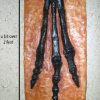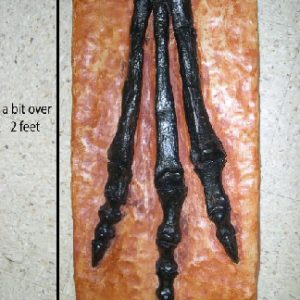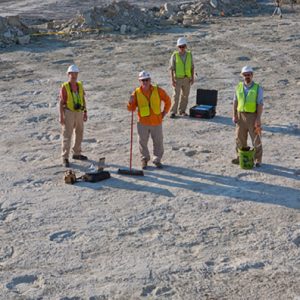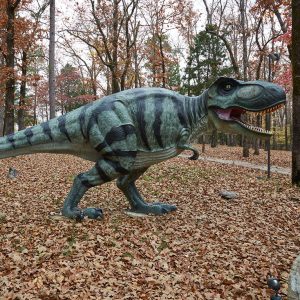calsfoundation@cals.org
Dinosaurs
Dinosaurs are a group of hundreds of species of reptiles that lived from the late Triassic through the Cretaceous geologic periods, from approximately 243 million years ago until approximately sixty-five million years ago. Dinosaurs came in many shapes and sizes; some species flew, while others walked, and still others lived only in the oceans. However, only a handful of species of dinosaurs are known to have lived in what would become Arkansas.
Overall, dinosaurs differed from many modern reptiles in that their legs were typically under their bodies instead of being on their sides. Modern studies suggest that dinosaurs may have been warm-blooded (endothermic)—that is, able to regulate their own body heat. Like other reptiles, dinosaurs gave birth by laying eggs, and a number of nests with ancient dinosaur eggs have been discovered. Some species were strictly carnivorous, while others were herbivorous. Species of dinosaurs have been found across the globe. Paleontologists have theorized that modern birds evolved from avian species of dinosaurs over millions of years.
The first documented dinosaur bone was discovered in 1677 by Robert Plot, an English scientist. Many more remains were found. It was not until 1824 that English paleontologist William Buckland wrote the first scientific paper on the discovery of a jawbone of what he called a Megalosaurus that dinosaurs received their scientific name and became a field of scientific study.
The process of fossilization that preserves dinosaur bones and eggs takes many millennia. In this process, after the dinosaur dies and decays, only the skeleton is left. Water levels rise and sediments cover the bones and any footprints that survive. Sediments build up in layers over time, and the pressures harden the surviving bone into rock. This process can be disrupted and the remains destroyed through a variety of natural processes, which is why only portions of the dinosaur are sometimes found instead of an intact skeleton. In some cases, the locations of these remains are in areas difficult to access; however, thousands of remains have been found to give paleontologists enough evidence to form their theories.
Remains of creatures predating the dinosaurs by millions of years have been found across the state of Arkansas. Fossilized remains of ancient sharks from the age of the dinosaurs as well as shark teeth have also been found in the state. Most dinosaur remains and footprints in the state have been found in an area called the Holly Creek Formation in Howard County, a formation dating back to the Cretaceous Era (approximately 165–143 million years ago).
In Arkansas, only a handful of species of dinosaurs are believed by paleontologists to have existed in the area. Among them, plesiosaurs apparently swam in the shallow seas around what became the Ouachita Mountains; their remains have been found as far south as Antarctica. There were several different types of plesiosaurs, and the sizes discovered range from five feet long to almost fifty feet long. These were large predators that spent their entire lives swimming and hunting in the sea.
Pterosaur remains have been found in northeastern Arkansas. These were flying dinosaurs. The Pteranodon in particular had a wingspan of up to eighteen feet, was about eight feet long, and weighed about 110 pounds. These creatures lived approximately eighty-five million years ago.
Footprints of the giant dinosaur Sauroposeidon have been found the state. This dinosaur was a large herbivore, similar to the Brachiosaurus and Brontosaurus. It lived about 118–110 million years ago. It was a massive creature, about sixty feet tall and ninety feet long, with an extremely long neck. They weighed as much as fifty-five tons. Remains of the Sauroposeidon have also been found in Texas and southeastern Oklahoma.
The Arcocanthesaurus also lived in Arkansas during the Cretaceous Era. This was a powerful predator, similar to the famed Tyrannosaurus rex, which also ran on its hind legs. The Arcocanthesaurus lived 113–110 million years ago. Remains have been found in portions of southeastern Oklahoma, eastern Texas, and as far east as North Carolina. These creatures had spines along their backs, were about thirteen feet high and thirty-nine feet long, and weighed about six tons. Remains similar to those of this dinosaur have been found in southwestern Arkansas, but more study of the remains needs to be done before a positive identification can be made.
Fossilized footprints have also suggested that the Deinonychus may have lived in Arkansas in this period as well. This dinosaur is related to the Velociraptor and lived about 115–108 million years ago. These were predators that ran on their hind legs and reached a length of ten to eleven feet long and weighed 130–160 pounds.
The Arkansaurus (Arkansaurus fridayi) was discovered by J. B. Friday in a gravel pit near Lockesburg (Sevier County) in 1972. Dr. James Harrison Quinn of the University of Arkansas (UA) in Fayetteville (Washington County) assembled the fragments of foot bones and gave the dinosaur a name in 1973. ReBecca Hunt-Foster added to Quinn’s work in 2018, with research suggesting that the Arkansaurus in some ways resembled a modern ostrich but was much larger, perhaps fifteen feet long and weighing 300 pounds, living about 140–100 million years ago during the Cretaceous Period. This is the most complete set of dinosaur remains found in Arkansas.
Fossilized footprints of dinosaurs have been found in several areas of the state. One notable set was found in 1983 preserved in limestone near a gypsum mine in Nashville (Howard County). These footprints were along the ancient shoreline of approximately 100 million years ago. Another set was found near this location in 2011.
The topography of Arkansas shifted tremendously during the time that dinosaurs lived. For millions of years, much of the southern and eastern part of the state was covered by a sea. The decay of vegetation in the shallower areas of this sea toward the end of this marine era allowed the formation of oil in what became the ten southernmost counties of Arkansas over the ensuing eons. Much of the area of Texas and Oklahoma; portions of Colorado and New Mexico; and most of the Great Plains north into Canada to the Arctic Ocean were part of a great sea that geologists now call the Western Interior Seaway.
The age of the dinosaurs ended abruptly approximately sixty-five million years ago when an asteroid impact in the Yucatan Peninsula area caused a global mass extinction event, wiping out half of all animal species on Earth, including all dinosaur species.
Dinosaurs remain an area of intense interest by paleontologists as well as the general public. In 2017, state senator Greg Leding of Fayetteville filed a bill later passed by the Arkansas General Assembly that chose the Arkansaurus as the state’s official dinosaur. Arkansas was the ninth state to choose a state dinosaur. The Office of the State Geologist provides free educational materials on fossils and dinosaurs to educators and the public.
For additional information:
Benton, Michael J. Dinosaurs Rediscovered: The Revolution in Paleontology. New York: Thames and Hudson, 2020.
Brusatte, Steve. The Rise and Fall of the Dinosaurs: A New History of Their Lost World. New York: Mariner Books, 2018.
Hunt, ReBecca K., Daniel Chure, and Leo Carson Davis. “An Early Cretaceous Theropod Foot from Southwestern Arkansas.” Proceedings of the 2003 Arkansas Undergraduate Research Conference 10 (2003): 87–103.
Lockley, Martin, and Adrian Hunt. Dinosaur Tracks of Western North America. New York: Columbia University Press, 1999.
Marshak, Stephen. Essentials of Geology, 7th ed. New York: W. W. Norton, 2022.
Office of the State Geologist of Arkansas. “The Arkansas Dinosaur: ‘Arkansaurus fridayi.’” https://www.geology.arkansas.gov/docs/pdf/education/dino.pdf (accessed May 6, 2025).
Paul, Gregory S. The Princeton Field Guide to Dinosaurs, 3rd ed. Princeton, NJ: Princeton University Press, 2024.
Pittman, Jeffery G., and David D. Gillette. “The Briar Site: A New Sauropod Tracksite in Lower Cretaceous Beds of Arkansas.” In Dinosaur Tracks and Traces, edited by David D. Gillette and Martin G. Lockley. Cambridge: Cambridge University Press, 1989.
Quinn, James. “Arkansas Dinosaur.” Geological Society of America Abstracts with Programs 5 (1973): 276–277.
Kenneth Bridges
South Arkansas College








Comments
No comments on this entry yet.